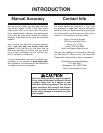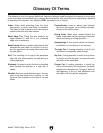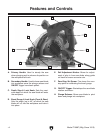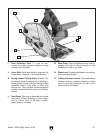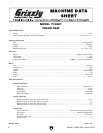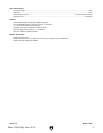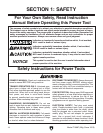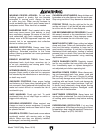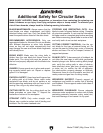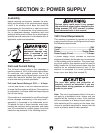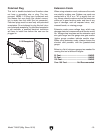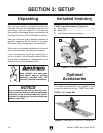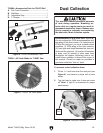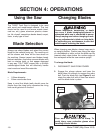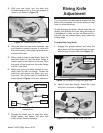
-10-
Model T10687 (Mfg. Since 10/12)
Additional Safety for Circular Saws
BLADE MAINTENANCE. Always ensure that the
saw blades are sharp, undamaged, and tightly
attached before each use. Only use blades that
meet the specifications listed on the data sheet.
RECOMMENDED ACCESSORIES. Only use
appropriate blades for this saw. Do not use blades
with different diameters or arbor hole shapes/
sizes, as they will not rotate concentrically and
may damage the saw and throw blade fragments
with deadly force.
RIVING KNIFE. Make sure the riving knife is
thicker than the saw blade but thinner than the
blade teeth. The riving knife must be present in
the kerf and properly adjusted with the blade to be
effective.
GUARDS. Ensure guards are in place and operat-
ing correctly before each cut. Repair or replace
guard if it is damaged.
PHYSICAL SAFETY. Keep hand and fingers clear
of cutting path at all times. Never reach under
workpiece near blade, and do not perform a cut
while supporting workpiece with one hand or bal-
ancing it on a leg or any other body part.
CUTTING DEPTH. Set the cutting depth so the
blade protrudes no more than
1
⁄8" beyond the
backside or bottom of the workpiece.
STRAIGHT CUTS. Only make straight cuts.
Always use a guide to reduce risk of binding and
kickback. Do not make freehand cuts!
STOPPING AND RESTARTING CUTS. Allow
blade to reach full speed before cutting. Complete
all cuts when possible. If a cut must be interrupted,
let blade come to a complete stop before removing
saw. Before resuming, place blade in center of kerf
and verify teeth do not contact workpiece.
CUTTING CORRECT MATERIAL. Use the cor-
rect blade for the type of material being cut. Do
not use this saw for cutting logs, roots, or trimming
shrubs and trees. Do not cut warped, twisted, or
cupped workpieces.
PLUNGE CUTS. To decrease risk of kickback, do
not allow the saw base to shift while performing
beveled plunge cuts. Before making blind plunge
cuts, verify the cutting path is clear of obstruc-
tions (electrical wires, gas lines, plumbing, metal
or stone, etc.) to reduce the risk of explosion,
fire, electrocution, property damage, or kickback.
Disconnect fuses or circuit breakers, and shut off
nearby water and gas lines if cutting nearby.
WORKPIECE SUPPORT. Properly support all
workpieces and cutoffs to reduce risk of binding
and kickback. Place supports under both sides of
the cut line.
WORKPIECE CLEARANCE. Ensure adequate
clearance under workpiece to reduce risk of blade
contacting materials (concrete, rocks, metal, etc.)
that could damage it and cause it to fly apart.
MAIN INJURY HAZARDS: Death, amputation, or lacerations from contacting the spinning saw
blade; blindness or eye injury from flying workpiece chips or tramp metals. To minimize your
risk of these hazards, always heed the following warning information:



